Evaluating Immigration Policies & Healthcare in Australia
VerifiedAdded on 2023/04/08
|12
|2091
|295
Report
AI Summary
This report examines Australia's immigration policies and their implications for the healthcare sector, particularly concerning the reliance on international healthcare workers. It analyzes data from 2006-2011 to assess the sustainability of current policies, considering historical reasons for strict immigration measures such as population concerns. The report highlights potential negative impacts on the healthcare system due to restrictive policies and weak enforcement, leading to mistreatment of migrant workers. It also provides recommendations for policy reforms, emphasizing the need for stronger regulations and protection of healthcare migrants' rights to ensure a sustainable and equitable healthcare workforce. Desklib offers this document as part of its collection of solved assignments for students.
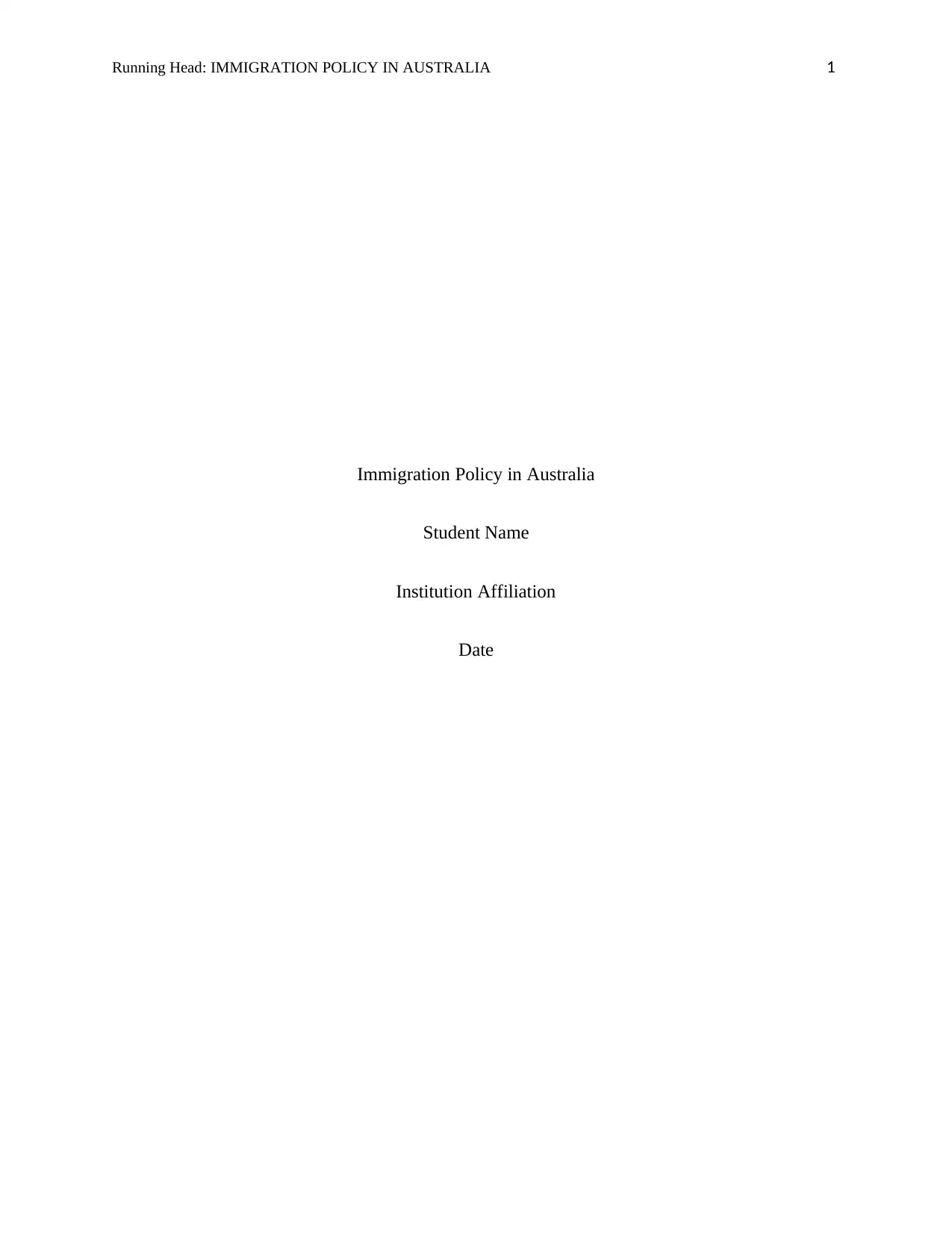
Running Head: IMMIGRATION POLICY IN AUSTRALIA 1
Immigration Policy in Australia
Student Name
Institution Affiliation
Date
Immigration Policy in Australia
Student Name
Institution Affiliation
Date
Paraphrase This Document
Need a fresh take? Get an instant paraphrase of this document with our AI Paraphraser
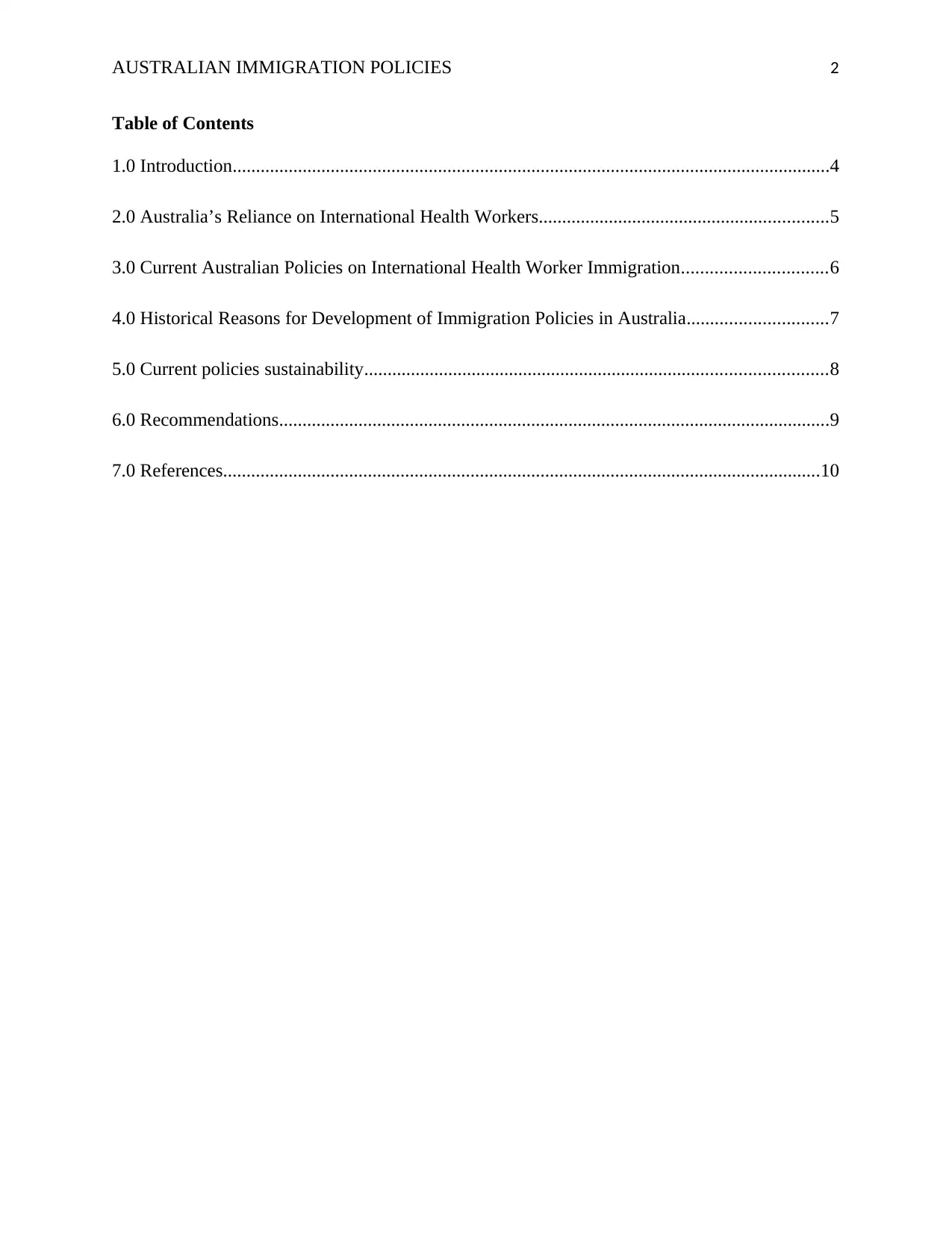
AUSTRALIAN IMMIGRATION POLICIES 2
Table of Contents
1.0 Introduction................................................................................................................................4
2.0 Australia’s Reliance on International Health Workers..............................................................5
3.0 Current Australian Policies on International Health Worker Immigration...............................6
4.0 Historical Reasons for Development of Immigration Policies in Australia..............................7
5.0 Current policies sustainability...................................................................................................8
6.0 Recommendations......................................................................................................................9
7.0 References................................................................................................................................10
Table of Contents
1.0 Introduction................................................................................................................................4
2.0 Australia’s Reliance on International Health Workers..............................................................5
3.0 Current Australian Policies on International Health Worker Immigration...............................6
4.0 Historical Reasons for Development of Immigration Policies in Australia..............................7
5.0 Current policies sustainability...................................................................................................8
6.0 Recommendations......................................................................................................................9
7.0 References................................................................................................................................10
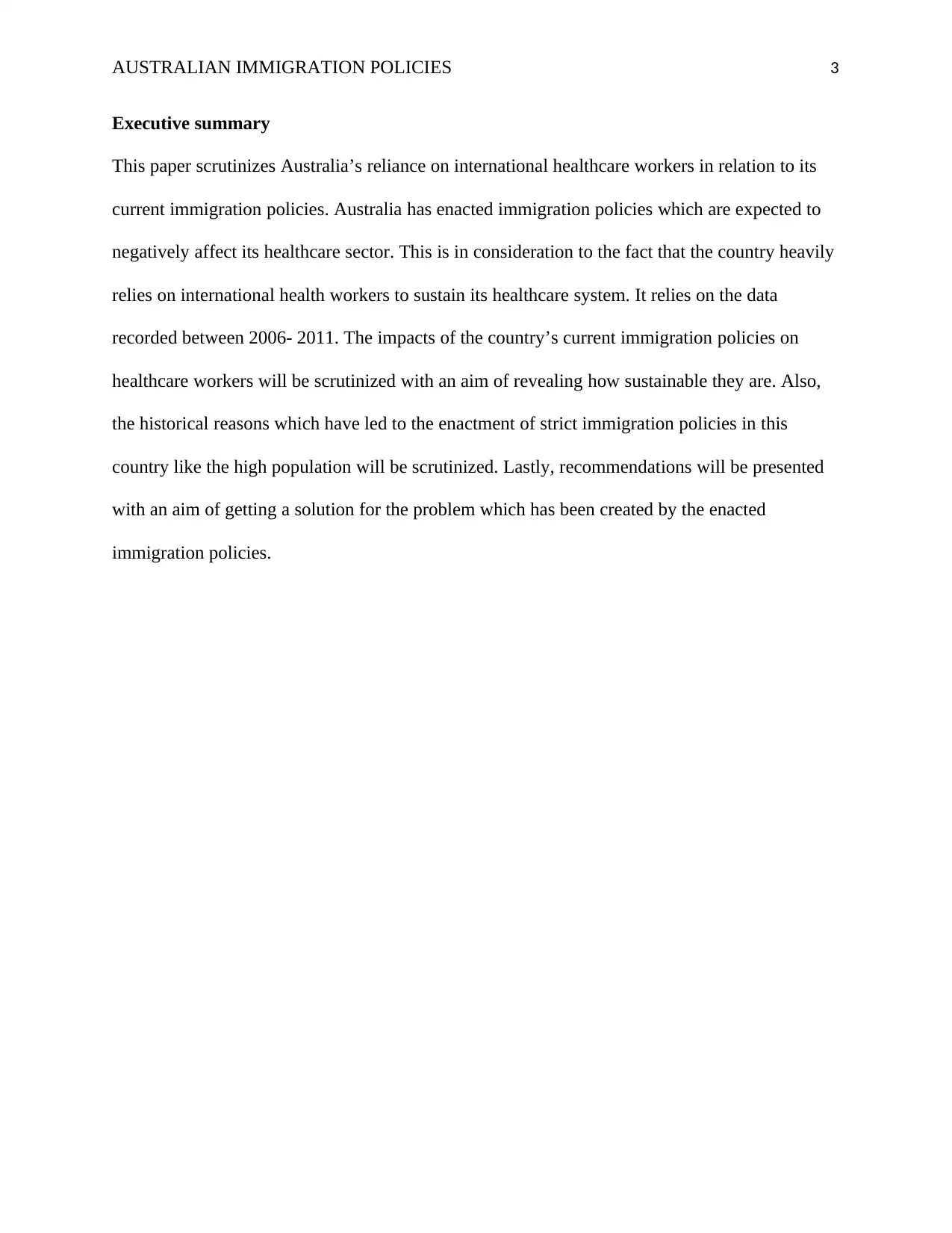
AUSTRALIAN IMMIGRATION POLICIES 3
Executive summary
This paper scrutinizes Australia’s reliance on international healthcare workers in relation to its
current immigration policies. Australia has enacted immigration policies which are expected to
negatively affect its healthcare sector. This is in consideration to the fact that the country heavily
relies on international health workers to sustain its healthcare system. It relies on the data
recorded between 2006- 2011. The impacts of the country’s current immigration policies on
healthcare workers will be scrutinized with an aim of revealing how sustainable they are. Also,
the historical reasons which have led to the enactment of strict immigration policies in this
country like the high population will be scrutinized. Lastly, recommendations will be presented
with an aim of getting a solution for the problem which has been created by the enacted
immigration policies.
Executive summary
This paper scrutinizes Australia’s reliance on international healthcare workers in relation to its
current immigration policies. Australia has enacted immigration policies which are expected to
negatively affect its healthcare sector. This is in consideration to the fact that the country heavily
relies on international health workers to sustain its healthcare system. It relies on the data
recorded between 2006- 2011. The impacts of the country’s current immigration policies on
healthcare workers will be scrutinized with an aim of revealing how sustainable they are. Also,
the historical reasons which have led to the enactment of strict immigration policies in this
country like the high population will be scrutinized. Lastly, recommendations will be presented
with an aim of getting a solution for the problem which has been created by the enacted
immigration policies.
⊘ This is a preview!⊘
Do you want full access?
Subscribe today to unlock all pages.

Trusted by 1+ million students worldwide
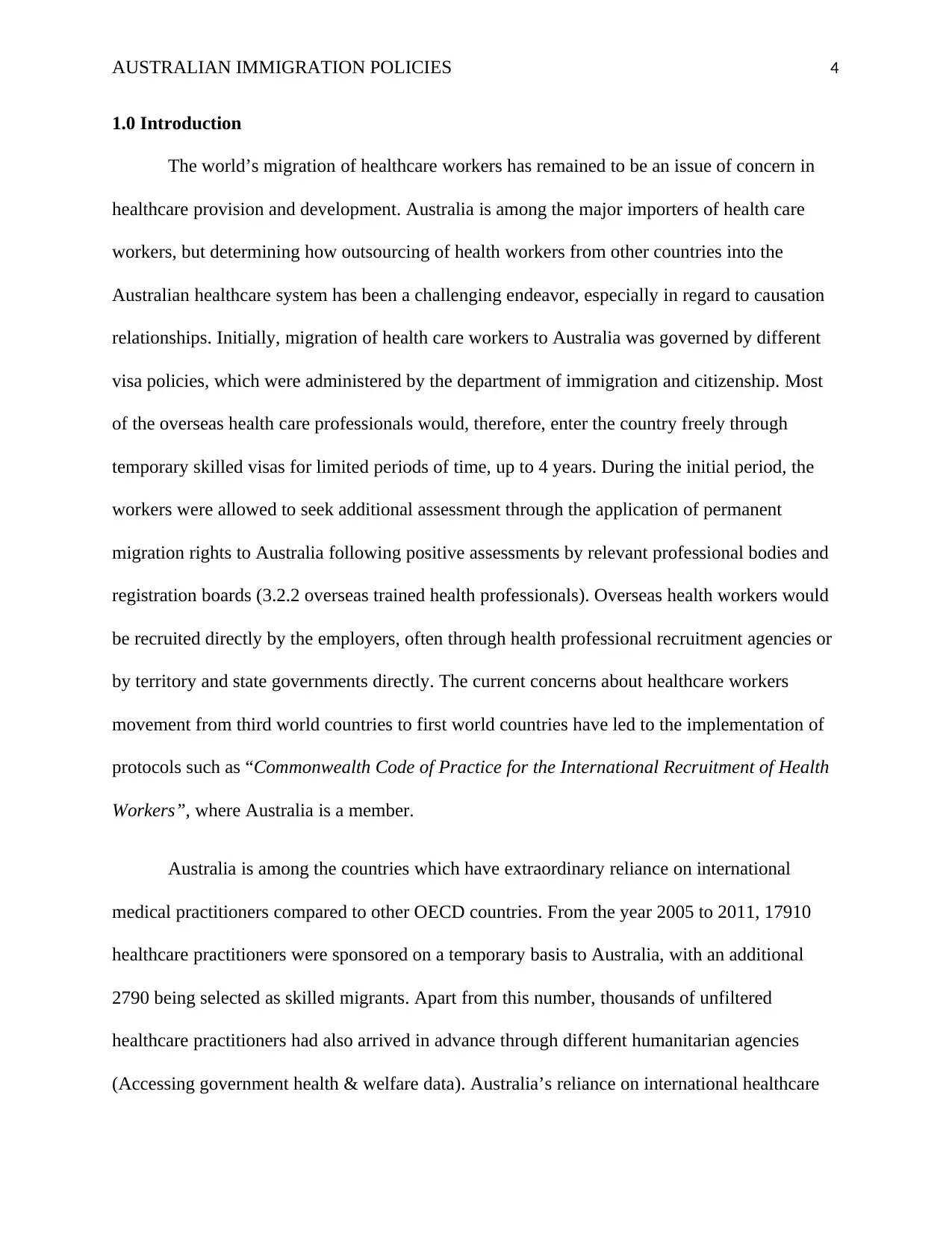
AUSTRALIAN IMMIGRATION POLICIES 4
1.0 Introduction
The world’s migration of healthcare workers has remained to be an issue of concern in
healthcare provision and development. Australia is among the major importers of health care
workers, but determining how outsourcing of health workers from other countries into the
Australian healthcare system has been a challenging endeavor, especially in regard to causation
relationships. Initially, migration of health care workers to Australia was governed by different
visa policies, which were administered by the department of immigration and citizenship. Most
of the overseas health care professionals would, therefore, enter the country freely through
temporary skilled visas for limited periods of time, up to 4 years. During the initial period, the
workers were allowed to seek additional assessment through the application of permanent
migration rights to Australia following positive assessments by relevant professional bodies and
registration boards (3.2.2 overseas trained health professionals). Overseas health workers would
be recruited directly by the employers, often through health professional recruitment agencies or
by territory and state governments directly. The current concerns about healthcare workers
movement from third world countries to first world countries have led to the implementation of
protocols such as “Commonwealth Code of Practice for the International Recruitment of Health
Workers”, where Australia is a member.
Australia is among the countries which have extraordinary reliance on international
medical practitioners compared to other OECD countries. From the year 2005 to 2011, 17910
healthcare practitioners were sponsored on a temporary basis to Australia, with an additional
2790 being selected as skilled migrants. Apart from this number, thousands of unfiltered
healthcare practitioners had also arrived in advance through different humanitarian agencies
(Accessing government health & welfare data). Australia’s reliance on international healthcare
1.0 Introduction
The world’s migration of healthcare workers has remained to be an issue of concern in
healthcare provision and development. Australia is among the major importers of health care
workers, but determining how outsourcing of health workers from other countries into the
Australian healthcare system has been a challenging endeavor, especially in regard to causation
relationships. Initially, migration of health care workers to Australia was governed by different
visa policies, which were administered by the department of immigration and citizenship. Most
of the overseas health care professionals would, therefore, enter the country freely through
temporary skilled visas for limited periods of time, up to 4 years. During the initial period, the
workers were allowed to seek additional assessment through the application of permanent
migration rights to Australia following positive assessments by relevant professional bodies and
registration boards (3.2.2 overseas trained health professionals). Overseas health workers would
be recruited directly by the employers, often through health professional recruitment agencies or
by territory and state governments directly. The current concerns about healthcare workers
movement from third world countries to first world countries have led to the implementation of
protocols such as “Commonwealth Code of Practice for the International Recruitment of Health
Workers”, where Australia is a member.
Australia is among the countries which have extraordinary reliance on international
medical practitioners compared to other OECD countries. From the year 2005 to 2011, 17910
healthcare practitioners were sponsored on a temporary basis to Australia, with an additional
2790 being selected as skilled migrants. Apart from this number, thousands of unfiltered
healthcare practitioners had also arrived in advance through different humanitarian agencies
(Accessing government health & welfare data). Australia’s reliance on international healthcare
Paraphrase This Document
Need a fresh take? Get an instant paraphrase of this document with our AI Paraphraser
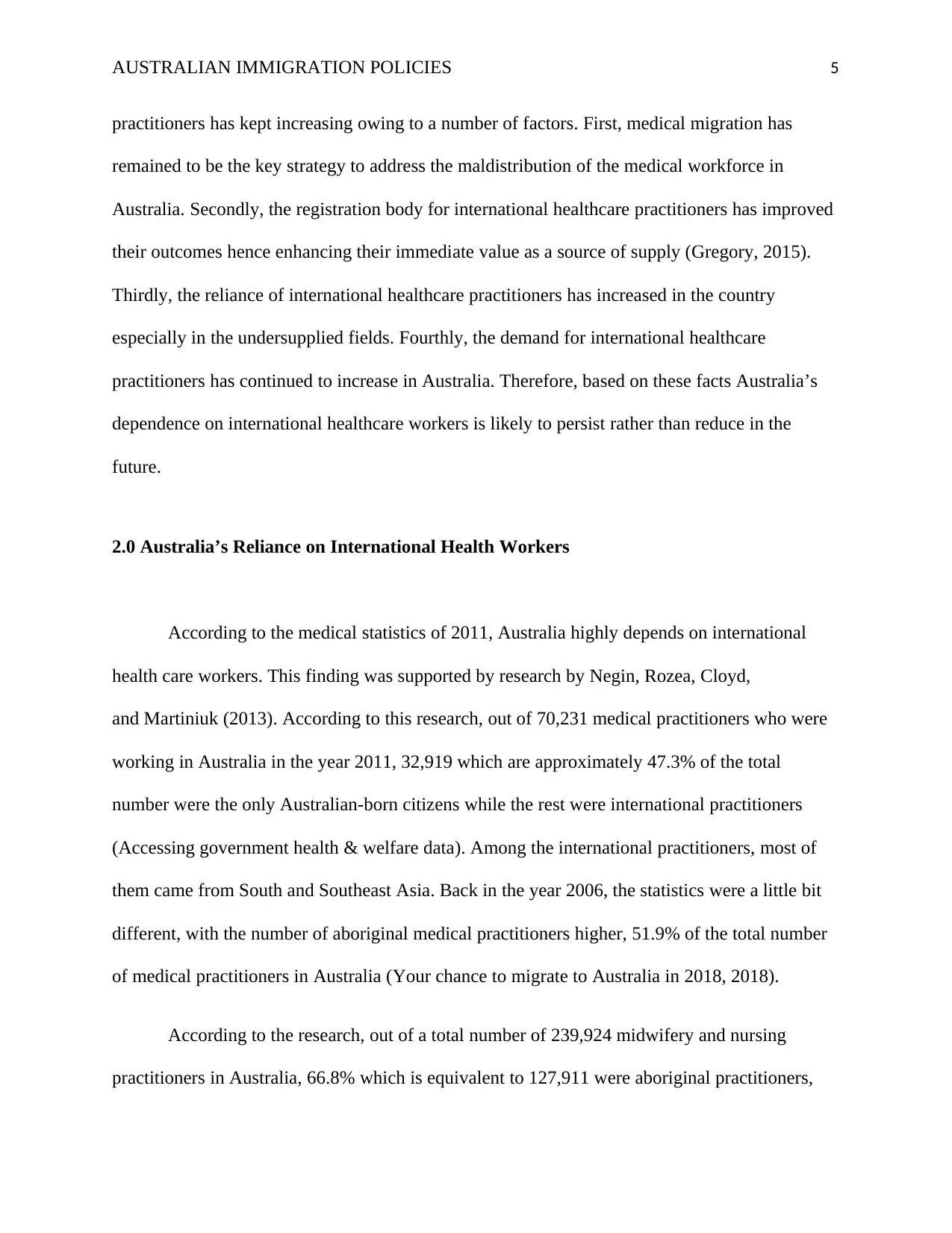
AUSTRALIAN IMMIGRATION POLICIES 5
practitioners has kept increasing owing to a number of factors. First, medical migration has
remained to be the key strategy to address the maldistribution of the medical workforce in
Australia. Secondly, the registration body for international healthcare practitioners has improved
their outcomes hence enhancing their immediate value as a source of supply (Gregory, 2015).
Thirdly, the reliance of international healthcare practitioners has increased in the country
especially in the undersupplied fields. Fourthly, the demand for international healthcare
practitioners has continued to increase in Australia. Therefore, based on these facts Australia’s
dependence on international healthcare workers is likely to persist rather than reduce in the
future.
2.0 Australia’s Reliance on International Health Workers
According to the medical statistics of 2011, Australia highly depends on international
health care workers. This finding was supported by research by Negin, Rozea, Cloyd,
and Martiniuk (2013). According to this research, out of 70,231 medical practitioners who were
working in Australia in the year 2011, 32,919 which are approximately 47.3% of the total
number were the only Australian-born citizens while the rest were international practitioners
(Accessing government health & welfare data). Among the international practitioners, most of
them came from South and Southeast Asia. Back in the year 2006, the statistics were a little bit
different, with the number of aboriginal medical practitioners higher, 51.9% of the total number
of medical practitioners in Australia (Your chance to migrate to Australia in 2018, 2018).
According to the research, out of a total number of 239,924 midwifery and nursing
practitioners in Australia, 66.8% which is equivalent to 127,911 were aboriginal practitioners,
practitioners has kept increasing owing to a number of factors. First, medical migration has
remained to be the key strategy to address the maldistribution of the medical workforce in
Australia. Secondly, the registration body for international healthcare practitioners has improved
their outcomes hence enhancing their immediate value as a source of supply (Gregory, 2015).
Thirdly, the reliance of international healthcare practitioners has increased in the country
especially in the undersupplied fields. Fourthly, the demand for international healthcare
practitioners has continued to increase in Australia. Therefore, based on these facts Australia’s
dependence on international healthcare workers is likely to persist rather than reduce in the
future.
2.0 Australia’s Reliance on International Health Workers
According to the medical statistics of 2011, Australia highly depends on international
health care workers. This finding was supported by research by Negin, Rozea, Cloyd,
and Martiniuk (2013). According to this research, out of 70,231 medical practitioners who were
working in Australia in the year 2011, 32,919 which are approximately 47.3% of the total
number were the only Australian-born citizens while the rest were international practitioners
(Accessing government health & welfare data). Among the international practitioners, most of
them came from South and Southeast Asia. Back in the year 2006, the statistics were a little bit
different, with the number of aboriginal medical practitioners higher, 51.9% of the total number
of medical practitioners in Australia (Your chance to migrate to Australia in 2018, 2018).
According to the research, out of a total number of 239,924 midwifery and nursing
practitioners in Australia, 66.8% which is equivalent to 127,911 were aboriginal practitioners,

AUSTRALIAN IMMIGRATION POLICIES 6
while the rest were international practitioners mainly from UK, South Asia, and Ireland
(Mossialos, Wenzl, Osborn & Sarnak, 2016). Compared to the preceding statistics of 2006, a
slight difference is noted. This is because, in 2006, approximately 69.8% of all the nursing and
midwifery practitioners were Aboriginals in Australia. Based on the research, the Western
Australia had the highest number of international practitioners compared to all the other regions
(Accessing government health & welfare data). Also, most of the medical practitioners in
Australia are aboriginals compared to urban areas where international practitioners have
dominated
Contradicting statistics were however evident when high-level medical practitioners were
put into consideration. Those practitioners include dentists, pharmacists, gynecologists, and other
allied practitioners. According to this research, out of a total number of 15,168 high-level
practitioners who worked in the country between 2006 and 2011, 68.9% which is equivalent to
10452 workers were international practitioners (Allen, 2019). The largest contributors to this
number were: Indians, Philippines, Nepalese and Zimbabweans. The number of healthcare
foreigners has continued to increase as more countries advance their healthcare education
systems and that has also translated to an increased number of healthcare practitioners who are
migrating into Australia to seek employment opportunities (Restrictions on Immigration in
Australia, 2019).
3.0 Immigration Policies in Australian
One of the current Australian policies on foreigners is the shift towards temporary
immigration policy. This policy places the immigration system of Australia at the risk of losing
while the rest were international practitioners mainly from UK, South Asia, and Ireland
(Mossialos, Wenzl, Osborn & Sarnak, 2016). Compared to the preceding statistics of 2006, a
slight difference is noted. This is because, in 2006, approximately 69.8% of all the nursing and
midwifery practitioners were Aboriginals in Australia. Based on the research, the Western
Australia had the highest number of international practitioners compared to all the other regions
(Accessing government health & welfare data). Also, most of the medical practitioners in
Australia are aboriginals compared to urban areas where international practitioners have
dominated
Contradicting statistics were however evident when high-level medical practitioners were
put into consideration. Those practitioners include dentists, pharmacists, gynecologists, and other
allied practitioners. According to this research, out of a total number of 15,168 high-level
practitioners who worked in the country between 2006 and 2011, 68.9% which is equivalent to
10452 workers were international practitioners (Allen, 2019). The largest contributors to this
number were: Indians, Philippines, Nepalese and Zimbabweans. The number of healthcare
foreigners has continued to increase as more countries advance their healthcare education
systems and that has also translated to an increased number of healthcare practitioners who are
migrating into Australia to seek employment opportunities (Restrictions on Immigration in
Australia, 2019).
3.0 Immigration Policies in Australian
One of the current Australian policies on foreigners is the shift towards temporary
immigration policy. This policy places the immigration system of Australia at the risk of losing
⊘ This is a preview!⊘
Do you want full access?
Subscribe today to unlock all pages.

Trusted by 1+ million students worldwide
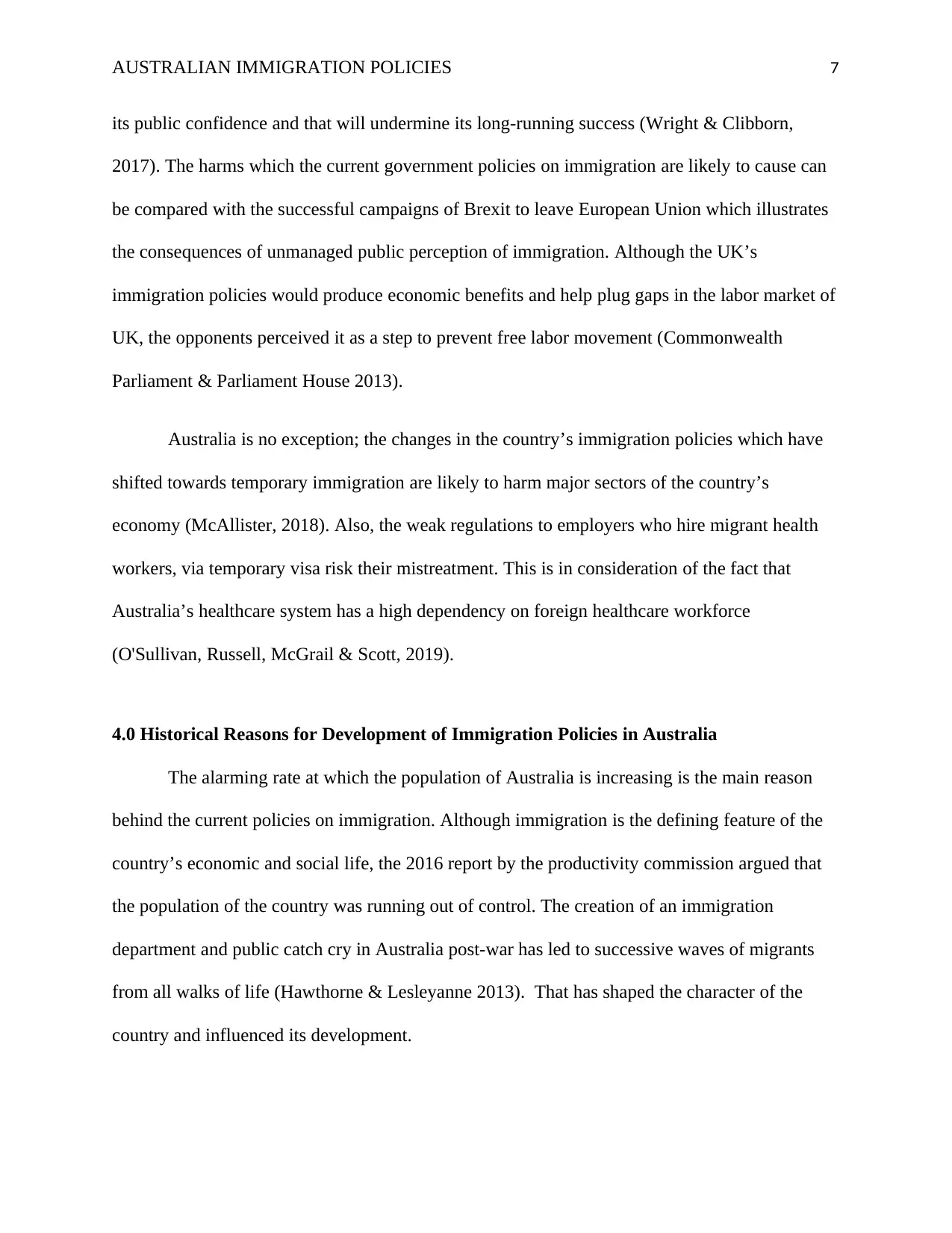
AUSTRALIAN IMMIGRATION POLICIES 7
its public confidence and that will undermine its long-running success (Wright & Clibborn,
2017). The harms which the current government policies on immigration are likely to cause can
be compared with the successful campaigns of Brexit to leave European Union which illustrates
the consequences of unmanaged public perception of immigration. Although the UK’s
immigration policies would produce economic benefits and help plug gaps in the labor market of
UK, the opponents perceived it as a step to prevent free labor movement (Commonwealth
Parliament & Parliament House 2013).
Australia is no exception; the changes in the country’s immigration policies which have
shifted towards temporary immigration are likely to harm major sectors of the country’s
economy (McAllister, 2018). Also, the weak regulations to employers who hire migrant health
workers, via temporary visa risk their mistreatment. This is in consideration of the fact that
Australia’s healthcare system has a high dependency on foreign healthcare workforce
(O'Sullivan, Russell, McGrail & Scott, 2019).
4.0 Historical Reasons for Development of Immigration Policies in Australia
The alarming rate at which the population of Australia is increasing is the main reason
behind the current policies on immigration. Although immigration is the defining feature of the
country’s economic and social life, the 2016 report by the productivity commission argued that
the population of the country was running out of control. The creation of an immigration
department and public catch cry in Australia post-war has led to successive waves of migrants
from all walks of life (Hawthorne & Lesleyanne 2013). That has shaped the character of the
country and influenced its development.
its public confidence and that will undermine its long-running success (Wright & Clibborn,
2017). The harms which the current government policies on immigration are likely to cause can
be compared with the successful campaigns of Brexit to leave European Union which illustrates
the consequences of unmanaged public perception of immigration. Although the UK’s
immigration policies would produce economic benefits and help plug gaps in the labor market of
UK, the opponents perceived it as a step to prevent free labor movement (Commonwealth
Parliament & Parliament House 2013).
Australia is no exception; the changes in the country’s immigration policies which have
shifted towards temporary immigration are likely to harm major sectors of the country’s
economy (McAllister, 2018). Also, the weak regulations to employers who hire migrant health
workers, via temporary visa risk their mistreatment. This is in consideration of the fact that
Australia’s healthcare system has a high dependency on foreign healthcare workforce
(O'Sullivan, Russell, McGrail & Scott, 2019).
4.0 Historical Reasons for Development of Immigration Policies in Australia
The alarming rate at which the population of Australia is increasing is the main reason
behind the current policies on immigration. Although immigration is the defining feature of the
country’s economic and social life, the 2016 report by the productivity commission argued that
the population of the country was running out of control. The creation of an immigration
department and public catch cry in Australia post-war has led to successive waves of migrants
from all walks of life (Hawthorne & Lesleyanne 2013). That has shaped the character of the
country and influenced its development.
Paraphrase This Document
Need a fresh take? Get an instant paraphrase of this document with our AI Paraphraser
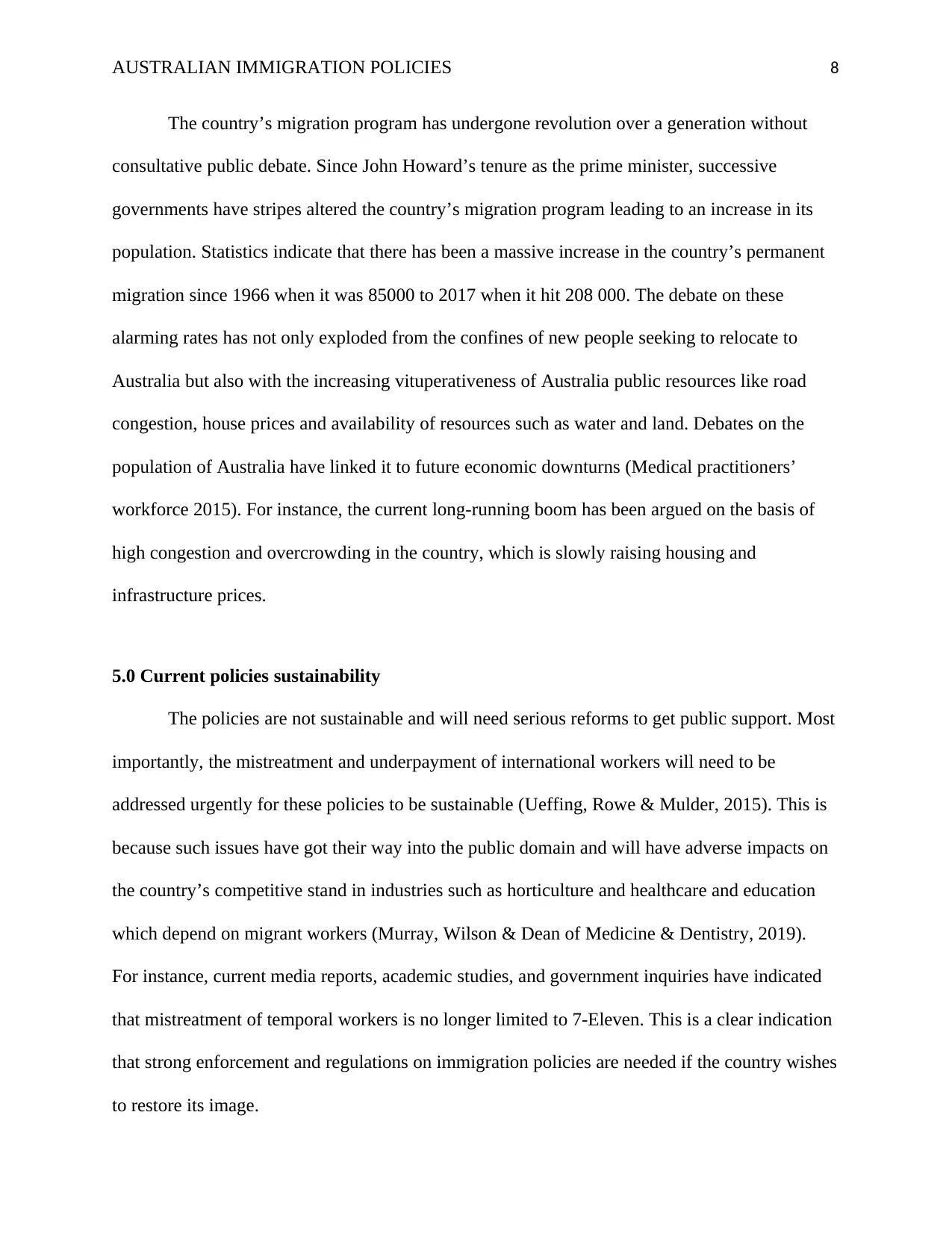
AUSTRALIAN IMMIGRATION POLICIES 8
The country’s migration program has undergone revolution over a generation without
consultative public debate. Since John Howard’s tenure as the prime minister, successive
governments have stripes altered the country’s migration program leading to an increase in its
population. Statistics indicate that there has been a massive increase in the country’s permanent
migration since 1966 when it was 85000 to 2017 when it hit 208 000. The debate on these
alarming rates has not only exploded from the confines of new people seeking to relocate to
Australia but also with the increasing vituperativeness of Australia public resources like road
congestion, house prices and availability of resources such as water and land. Debates on the
population of Australia have linked it to future economic downturns (Medical practitioners’
workforce 2015). For instance, the current long-running boom has been argued on the basis of
high congestion and overcrowding in the country, which is slowly raising housing and
infrastructure prices.
5.0 Current policies sustainability
The policies are not sustainable and will need serious reforms to get public support. Most
importantly, the mistreatment and underpayment of international workers will need to be
addressed urgently for these policies to be sustainable (Ueffing, Rowe & Mulder, 2015). This is
because such issues have got their way into the public domain and will have adverse impacts on
the country’s competitive stand in industries such as horticulture and healthcare and education
which depend on migrant workers (Murray, Wilson & Dean of Medicine & Dentistry, 2019).
For instance, current media reports, academic studies, and government inquiries have indicated
that mistreatment of temporal workers is no longer limited to 7-Eleven. This is a clear indication
that strong enforcement and regulations on immigration policies are needed if the country wishes
to restore its image.
The country’s migration program has undergone revolution over a generation without
consultative public debate. Since John Howard’s tenure as the prime minister, successive
governments have stripes altered the country’s migration program leading to an increase in its
population. Statistics indicate that there has been a massive increase in the country’s permanent
migration since 1966 when it was 85000 to 2017 when it hit 208 000. The debate on these
alarming rates has not only exploded from the confines of new people seeking to relocate to
Australia but also with the increasing vituperativeness of Australia public resources like road
congestion, house prices and availability of resources such as water and land. Debates on the
population of Australia have linked it to future economic downturns (Medical practitioners’
workforce 2015). For instance, the current long-running boom has been argued on the basis of
high congestion and overcrowding in the country, which is slowly raising housing and
infrastructure prices.
5.0 Current policies sustainability
The policies are not sustainable and will need serious reforms to get public support. Most
importantly, the mistreatment and underpayment of international workers will need to be
addressed urgently for these policies to be sustainable (Ueffing, Rowe & Mulder, 2015). This is
because such issues have got their way into the public domain and will have adverse impacts on
the country’s competitive stand in industries such as horticulture and healthcare and education
which depend on migrant workers (Murray, Wilson & Dean of Medicine & Dentistry, 2019).
For instance, current media reports, academic studies, and government inquiries have indicated
that mistreatment of temporal workers is no longer limited to 7-Eleven. This is a clear indication
that strong enforcement and regulations on immigration policies are needed if the country wishes
to restore its image.
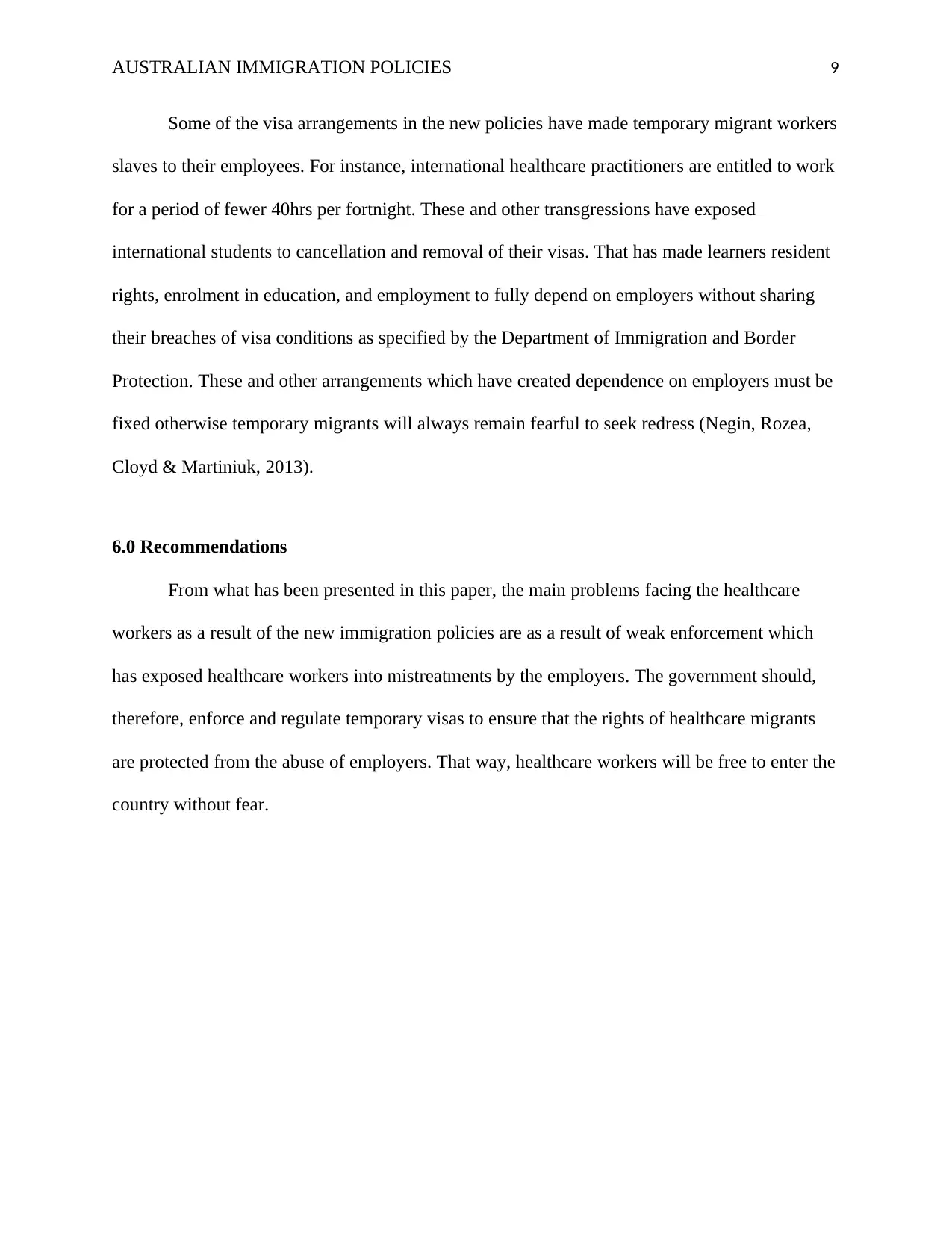
AUSTRALIAN IMMIGRATION POLICIES 9
Some of the visa arrangements in the new policies have made temporary migrant workers
slaves to their employees. For instance, international healthcare practitioners are entitled to work
for a period of fewer 40hrs per fortnight. These and other transgressions have exposed
international students to cancellation and removal of their visas. That has made learners resident
rights, enrolment in education, and employment to fully depend on employers without sharing
their breaches of visa conditions as specified by the Department of Immigration and Border
Protection. These and other arrangements which have created dependence on employers must be
fixed otherwise temporary migrants will always remain fearful to seek redress (Negin, Rozea,
Cloyd & Martiniuk, 2013).
6.0 Recommendations
From what has been presented in this paper, the main problems facing the healthcare
workers as a result of the new immigration policies are as a result of weak enforcement which
has exposed healthcare workers into mistreatments by the employers. The government should,
therefore, enforce and regulate temporary visas to ensure that the rights of healthcare migrants
are protected from the abuse of employers. That way, healthcare workers will be free to enter the
country without fear.
Some of the visa arrangements in the new policies have made temporary migrant workers
slaves to their employees. For instance, international healthcare practitioners are entitled to work
for a period of fewer 40hrs per fortnight. These and other transgressions have exposed
international students to cancellation and removal of their visas. That has made learners resident
rights, enrolment in education, and employment to fully depend on employers without sharing
their breaches of visa conditions as specified by the Department of Immigration and Border
Protection. These and other arrangements which have created dependence on employers must be
fixed otherwise temporary migrants will always remain fearful to seek redress (Negin, Rozea,
Cloyd & Martiniuk, 2013).
6.0 Recommendations
From what has been presented in this paper, the main problems facing the healthcare
workers as a result of the new immigration policies are as a result of weak enforcement which
has exposed healthcare workers into mistreatments by the employers. The government should,
therefore, enforce and regulate temporary visas to ensure that the rights of healthcare migrants
are protected from the abuse of employers. That way, healthcare workers will be free to enter the
country without fear.
⊘ This is a preview!⊘
Do you want full access?
Subscribe today to unlock all pages.

Trusted by 1+ million students worldwide
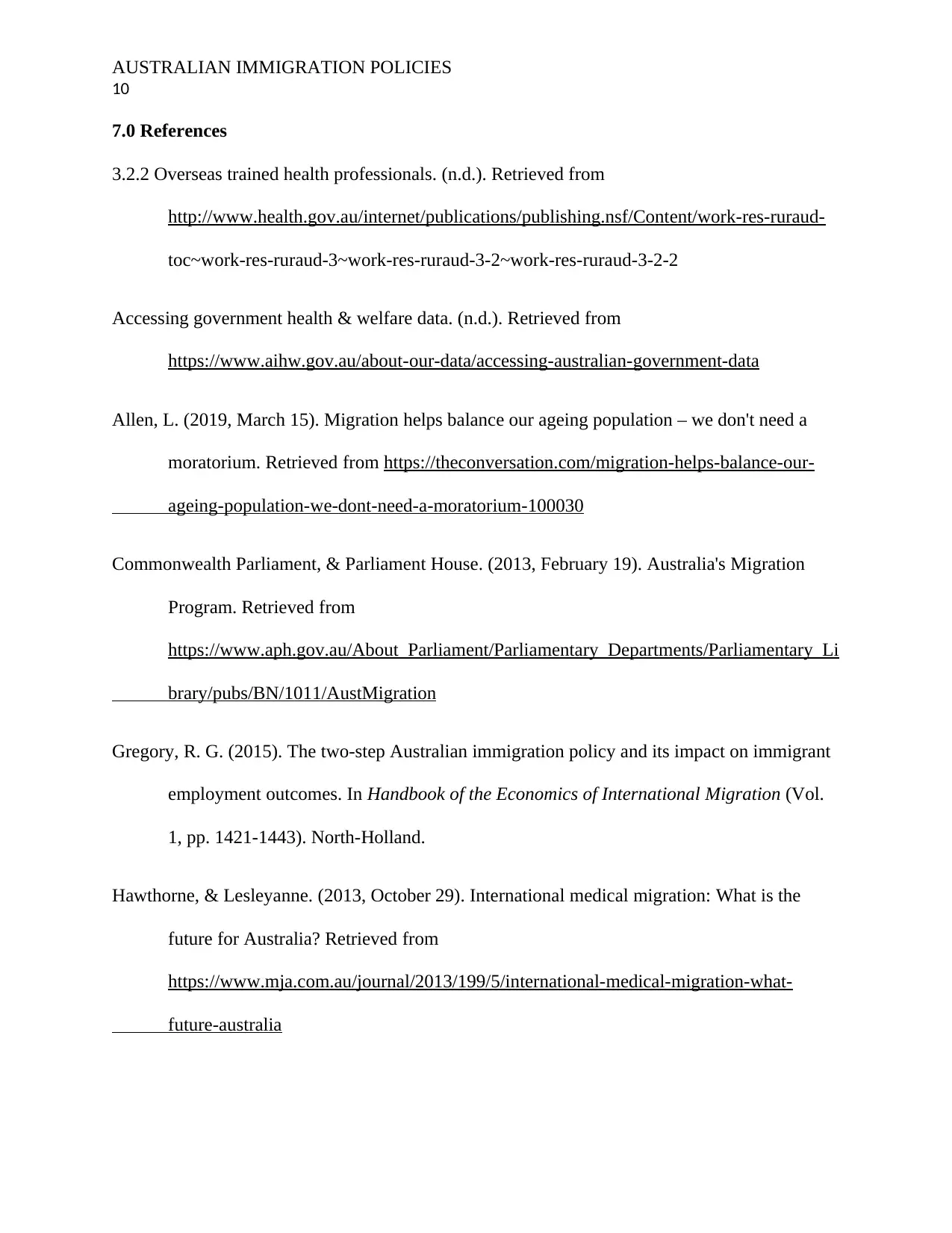
AUSTRALIAN IMMIGRATION POLICIES
10
7.0 References
3.2.2 Overseas trained health professionals. (n.d.). Retrieved from
http://www.health.gov.au/internet/publications/publishing.nsf/Content/work-res-ruraud-
toc~work-res-ruraud-3~work-res-ruraud-3-2~work-res-ruraud-3-2-2
Accessing government health & welfare data. (n.d.). Retrieved from
https://www.aihw.gov.au/about-our-data/accessing-australian-government-data
Allen, L. (2019, March 15). Migration helps balance our ageing population – we don't need a
moratorium. Retrieved from https://theconversation.com/migration-helps-balance-our-
ageing-population-we-dont-need-a-moratorium-100030
Commonwealth Parliament, & Parliament House. (2013, February 19). Australia's Migration
Program. Retrieved from
https://www.aph.gov.au/About_Parliament/Parliamentary_Departments/Parliamentary_Li
brary/pubs/BN/1011/AustMigration
Gregory, R. G. (2015). The two-step Australian immigration policy and its impact on immigrant
employment outcomes. In Handbook of the Economics of International Migration (Vol.
1, pp. 1421-1443). North-Holland.
Hawthorne, & Lesleyanne. (2013, October 29). International medical migration: What is the
future for Australia? Retrieved from
https://www.mja.com.au/journal/2013/199/5/international-medical-migration-what-
future-australia
10
7.0 References
3.2.2 Overseas trained health professionals. (n.d.). Retrieved from
http://www.health.gov.au/internet/publications/publishing.nsf/Content/work-res-ruraud-
toc~work-res-ruraud-3~work-res-ruraud-3-2~work-res-ruraud-3-2-2
Accessing government health & welfare data. (n.d.). Retrieved from
https://www.aihw.gov.au/about-our-data/accessing-australian-government-data
Allen, L. (2019, March 15). Migration helps balance our ageing population – we don't need a
moratorium. Retrieved from https://theconversation.com/migration-helps-balance-our-
ageing-population-we-dont-need-a-moratorium-100030
Commonwealth Parliament, & Parliament House. (2013, February 19). Australia's Migration
Program. Retrieved from
https://www.aph.gov.au/About_Parliament/Parliamentary_Departments/Parliamentary_Li
brary/pubs/BN/1011/AustMigration
Gregory, R. G. (2015). The two-step Australian immigration policy and its impact on immigrant
employment outcomes. In Handbook of the Economics of International Migration (Vol.
1, pp. 1421-1443). North-Holland.
Hawthorne, & Lesleyanne. (2013, October 29). International medical migration: What is the
future for Australia? Retrieved from
https://www.mja.com.au/journal/2013/199/5/international-medical-migration-what-
future-australia
Paraphrase This Document
Need a fresh take? Get an instant paraphrase of this document with our AI Paraphraser
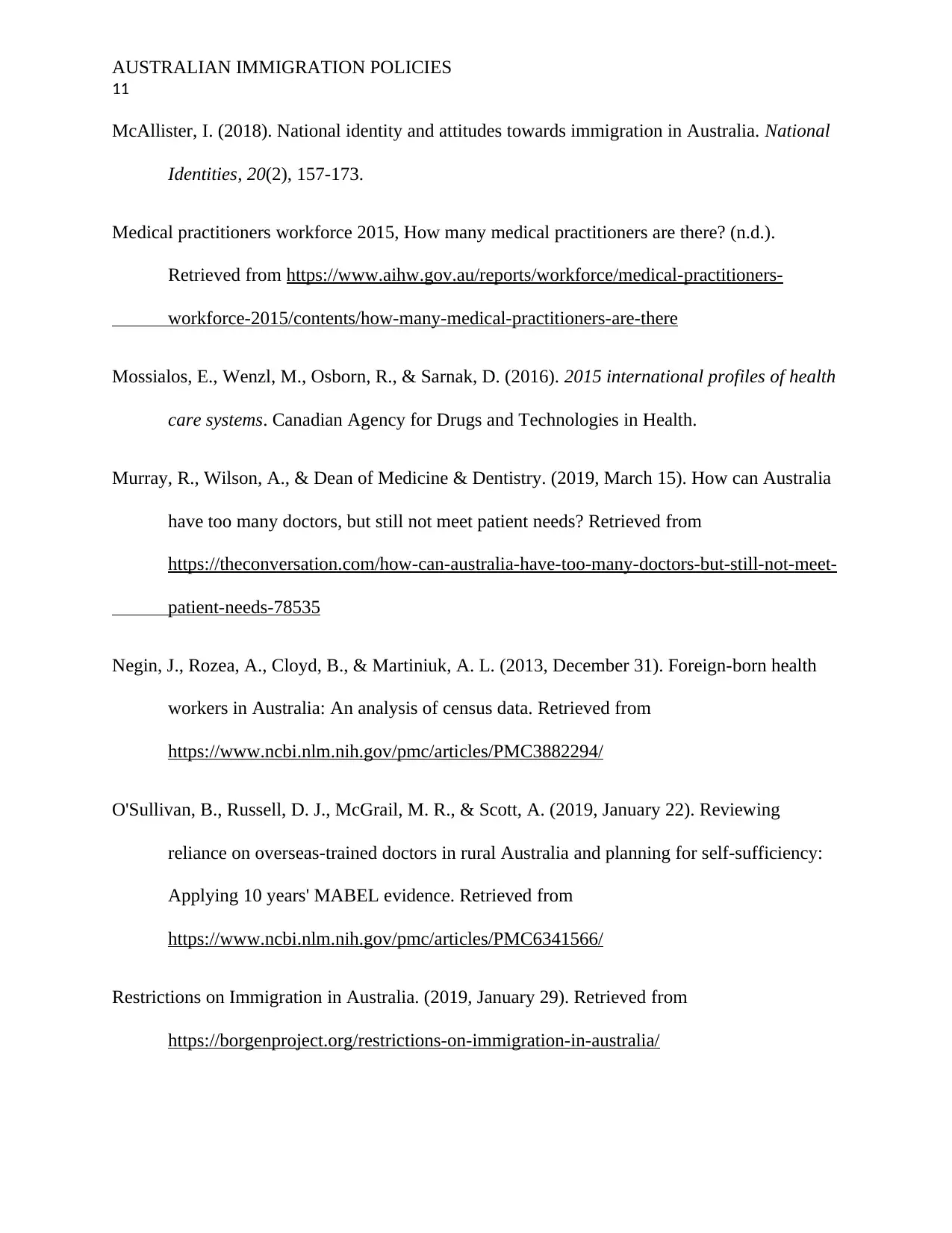
AUSTRALIAN IMMIGRATION POLICIES
11
McAllister, I. (2018). National identity and attitudes towards immigration in Australia. National
Identities, 20(2), 157-173.
Medical practitioners workforce 2015, How many medical practitioners are there? (n.d.).
Retrieved from https://www.aihw.gov.au/reports/workforce/medical-practitioners-
workforce-2015/contents/how-many-medical-practitioners-are-there
Mossialos, E., Wenzl, M., Osborn, R., & Sarnak, D. (2016). 2015 international profiles of health
care systems. Canadian Agency for Drugs and Technologies in Health.
Murray, R., Wilson, A., & Dean of Medicine & Dentistry. (2019, March 15). How can Australia
have too many doctors, but still not meet patient needs? Retrieved from
https://theconversation.com/how-can-australia-have-too-many-doctors-but-still-not-meet-
patient-needs-78535
Negin, J., Rozea, A., Cloyd, B., & Martiniuk, A. L. (2013, December 31). Foreign-born health
workers in Australia: An analysis of census data. Retrieved from
https://www.ncbi.nlm.nih.gov/pmc/articles/PMC3882294/
O'Sullivan, B., Russell, D. J., McGrail, M. R., & Scott, A. (2019, January 22). Reviewing
reliance on overseas-trained doctors in rural Australia and planning for self-sufficiency:
Applying 10 years' MABEL evidence. Retrieved from
https://www.ncbi.nlm.nih.gov/pmc/articles/PMC6341566/
Restrictions on Immigration in Australia. (2019, January 29). Retrieved from
https://borgenproject.org/restrictions-on-immigration-in-australia/
11
McAllister, I. (2018). National identity and attitudes towards immigration in Australia. National
Identities, 20(2), 157-173.
Medical practitioners workforce 2015, How many medical practitioners are there? (n.d.).
Retrieved from https://www.aihw.gov.au/reports/workforce/medical-practitioners-
workforce-2015/contents/how-many-medical-practitioners-are-there
Mossialos, E., Wenzl, M., Osborn, R., & Sarnak, D. (2016). 2015 international profiles of health
care systems. Canadian Agency for Drugs and Technologies in Health.
Murray, R., Wilson, A., & Dean of Medicine & Dentistry. (2019, March 15). How can Australia
have too many doctors, but still not meet patient needs? Retrieved from
https://theconversation.com/how-can-australia-have-too-many-doctors-but-still-not-meet-
patient-needs-78535
Negin, J., Rozea, A., Cloyd, B., & Martiniuk, A. L. (2013, December 31). Foreign-born health
workers in Australia: An analysis of census data. Retrieved from
https://www.ncbi.nlm.nih.gov/pmc/articles/PMC3882294/
O'Sullivan, B., Russell, D. J., McGrail, M. R., & Scott, A. (2019, January 22). Reviewing
reliance on overseas-trained doctors in rural Australia and planning for self-sufficiency:
Applying 10 years' MABEL evidence. Retrieved from
https://www.ncbi.nlm.nih.gov/pmc/articles/PMC6341566/
Restrictions on Immigration in Australia. (2019, January 29). Retrieved from
https://borgenproject.org/restrictions-on-immigration-in-australia/
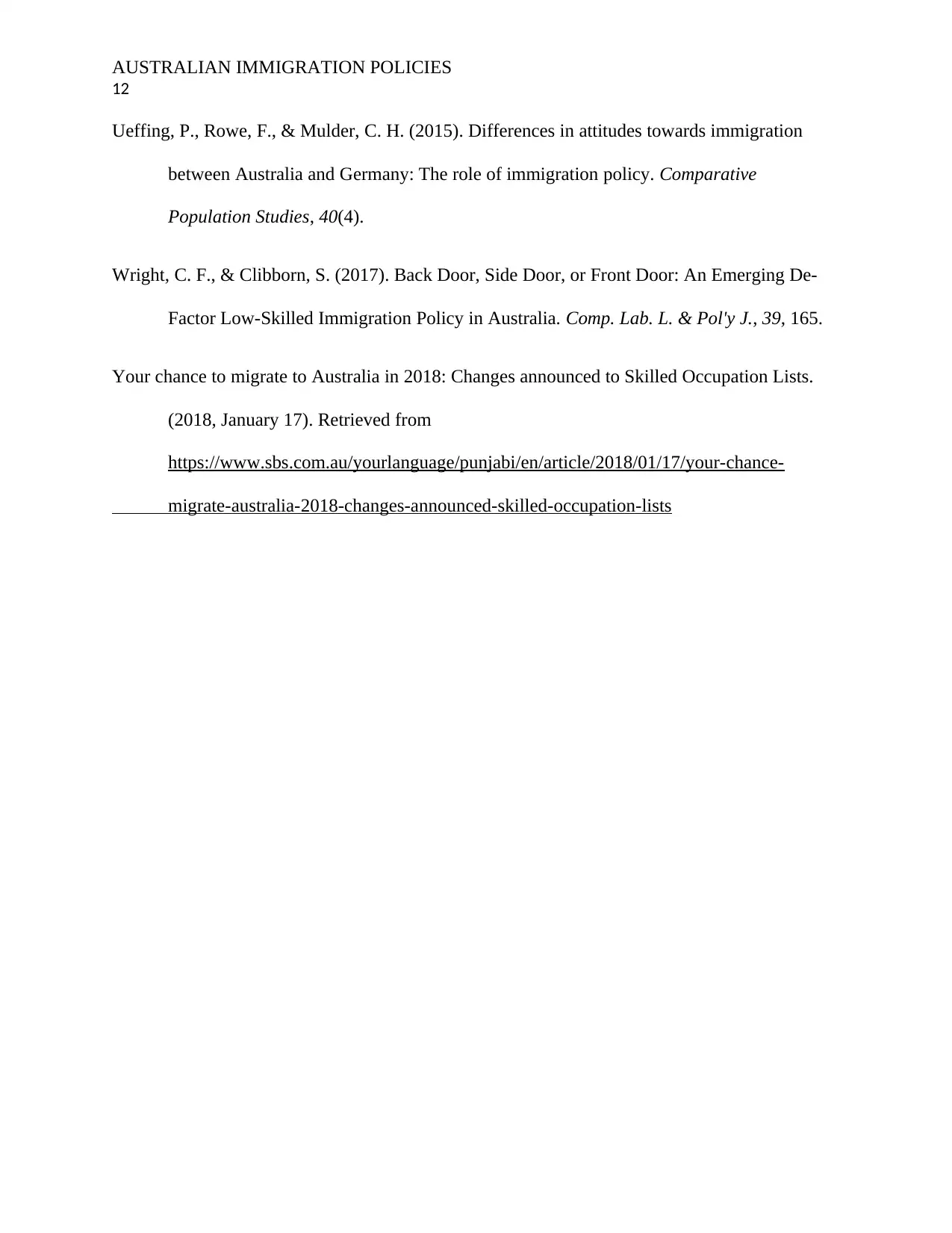
AUSTRALIAN IMMIGRATION POLICIES
12
Ueffing, P., Rowe, F., & Mulder, C. H. (2015). Differences in attitudes towards immigration
between Australia and Germany: The role of immigration policy. Comparative
Population Studies, 40(4).
Wright, C. F., & Clibborn, S. (2017). Back Door, Side Door, or Front Door: An Emerging De-
Factor Low-Skilled Immigration Policy in Australia. Comp. Lab. L. & Pol'y J., 39, 165.
Your chance to migrate to Australia in 2018: Changes announced to Skilled Occupation Lists.
(2018, January 17). Retrieved from
https://www.sbs.com.au/yourlanguage/punjabi/en/article/2018/01/17/your-chance-
migrate-australia-2018-changes-announced-skilled-occupation-lists
12
Ueffing, P., Rowe, F., & Mulder, C. H. (2015). Differences in attitudes towards immigration
between Australia and Germany: The role of immigration policy. Comparative
Population Studies, 40(4).
Wright, C. F., & Clibborn, S. (2017). Back Door, Side Door, or Front Door: An Emerging De-
Factor Low-Skilled Immigration Policy in Australia. Comp. Lab. L. & Pol'y J., 39, 165.
Your chance to migrate to Australia in 2018: Changes announced to Skilled Occupation Lists.
(2018, January 17). Retrieved from
https://www.sbs.com.au/yourlanguage/punjabi/en/article/2018/01/17/your-chance-
migrate-australia-2018-changes-announced-skilled-occupation-lists
⊘ This is a preview!⊘
Do you want full access?
Subscribe today to unlock all pages.

Trusted by 1+ million students worldwide
1 out of 12
Related Documents
Your All-in-One AI-Powered Toolkit for Academic Success.
+13062052269
info@desklib.com
Available 24*7 on WhatsApp / Email
![[object Object]](/_next/static/media/star-bottom.7253800d.svg)
Unlock your academic potential
Copyright © 2020–2025 A2Z Services. All Rights Reserved. Developed and managed by ZUCOL.





